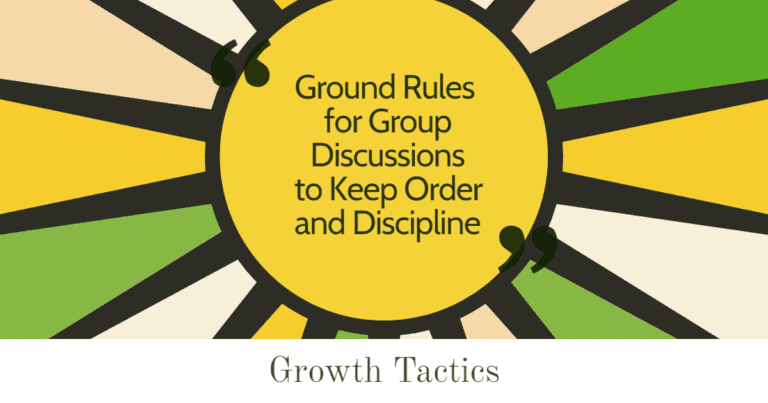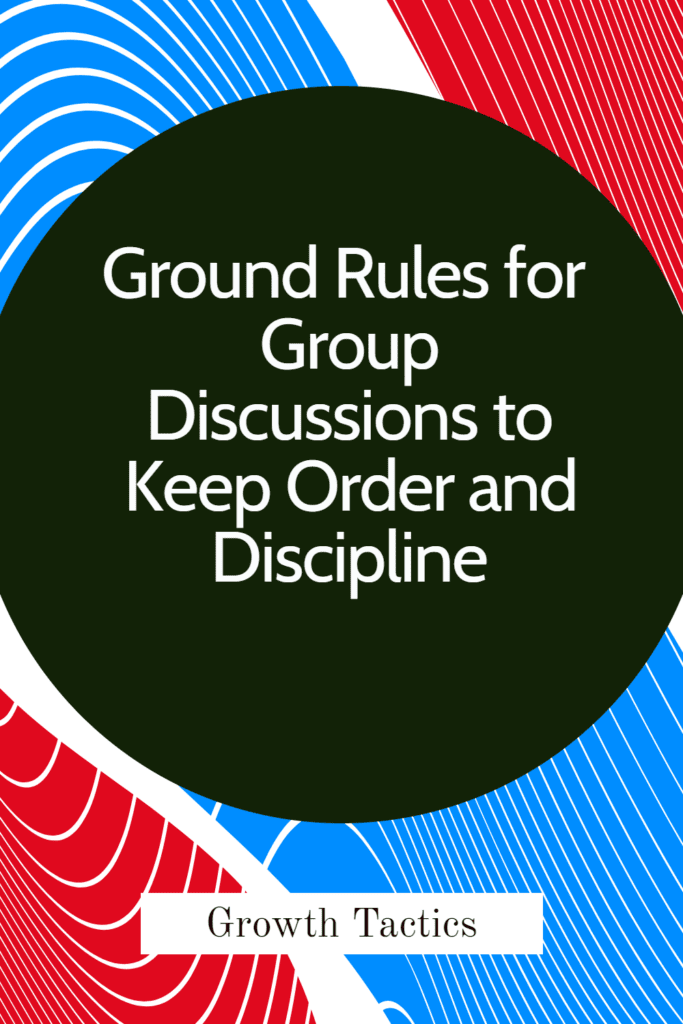Have you ever been a part of a group discussion that ended up being chaotic and unproductive? While group discussions are a powerful tool for sharing ideas and solving problems, they can quickly become disorganized without proper structure and guidelines.
That’s where ground rules come in. Ground rules provide the framework for a productive, respectful, and collaborative discussion. In this article, we’ll explore the importance of ground rules in group discussions and how they can help ensure that all participants have an equal opportunity to contribute and be heard.

Jump To Section
Establishing Ground Rules
To have a successful and effective group discussion, it is crucial to establish clear ground rules. These ground rules serve as a foundation for maintaining order, promoting active participation, and creating a respectful environment for all participants. Let’s delve into the process of establishing ground rules.
Defining ground rules
The first step in establishing ground rules is to define them. Ground rules can cover various aspects of the discussion, including behavior, communication, time management, and decision-making. They should be concise, specific, and relevant to the goals and objectives of the group discussion. For example, ground rules may include guidelines such as respecting others’ opinions, avoiding interruptions, and staying on topic.
Discussing and agreeing on ground rules
Once the ground rules have been defined, it is essential to involve all participants in a discussion about them. This allows everyone to have a voice in shaping the guidelines and increases their commitment to following them. Encourage open conversation and invite participants to share their thoughts and suggestions regarding the proposed ground rules. This collaborative approach fosters a sense of ownership and ensures that the ground rules are fair and inclusive.
During the discussion, it is important to address any concerns or conflicts that may arise concerning the proposed ground rules. Encourage participants to express their viewpoints and offer suggestions for modifications or additional rules, if necessary. The aim is to reach a consensus and agreement among all participants regarding the ground rules that will govern the group discussion.
Documenting ground rules
Once the ground rules are agreed upon, it is crucial to document them. This documentation serves as a reference point for all participants and helps to reinforce the expectations that have been set. The ground rules can be documented in a format that is easily accessible to all, such as a printed handout or a shared digital document. Make sure to distribute or share this document with all participants for their reference.
By documenting the ground rules, participants have a clear understanding of what is expected from them during the group discussion. It also provides a sense of accountability and reinforces the importance of adhering to the established guidelines. Having the ground rules documented also allows for easy reference and can be revisited or revised as needed in future discussions.

Creating a Structured Discussion Environment
To maximize the effectiveness of a group discussion, it’s important to create a structured environment that promotes engagement, collaboration, and respect among participants. Here are some key elements to consider when establishing a structured discussion environment.
Setting a clear agenda and objectives
Before starting the discussion, it’s crucial to set a clear agenda and objectives. This provides focus and direction, ensuring that participants stay on track and work towards a common goal. The agenda should outline the topics to be covered and the desired outcomes of the discussion. By clearly communicating the agenda and objectives at the beginning, participants can prepare and contribute more effectively.
Encouraging active participation
Active participation is essential for a productive group discussion. Encourage all participants to contribute their thoughts, ideas, and perspectives. Create an inclusive atmosphere where everyone feels comfortable sharing their opinions, even if their ideas may differ from others. Avoid dominating or monopolizing the discussion and give each participant an equal opportunity to speak. Prompting questions, group activities, and breakout sessions can also help facilitate active participation.
Maintaining respect and courtesy
Respect and courtesy are fundamental to a successful group discussion. Remind participants to listen actively and respectfully to others’ viewpoints, even if they disagree. Discourage interrupting or talking over others and ensure that all participants have a chance to express themselves fully. Model respectful behavior as the facilitator and hold participants accountable for maintaining a respectful environment. Establishing ground rules for respectful communication, as discussed earlier, can also help maintain a courteous atmosphere.
Providing structure and time management
A structured discussion benefits from clear organization and effective time management. Divide the discussion into segments or topics to ensure that each aspect receives sufficient attention. Set time limits for each segment and stick to them to maintain focus and efficiency. Designate a timekeeper to monitor and manage time allocations. Providing structure and maintaining time discipline helps prevent the discussion from veering off track or becoming unnecessarily prolonged.
Summarizing and synthesizing key points
Throughout the discussion, it’s important to summarize and synthesize the key points raised by participants. This helps maintain focus, consolidate ideas, and ensure that everyone is on the same page. As the facilitator, actively listen to participants and identify common themes or important takeaways. At the end of each segment or the discussion overall, provide a summary of the main points discussed and invite participants to contribute any additional insights.
By creating a structured discussion environment, participants can engage more effectively, collaborate seamlessly, and achieve the desired outcomes. Setting a clear agenda, encouraging active participation, maintaining respect and courtesy, providing structure and time management, and summarizing key points are all essential elements for facilitating a successful structured discussion environment.

Managing Different Perspectives
In any group discussion, participants will inevitably bring different perspectives, assumptions, and biases to the table. Managing these differences effectively is crucial for creating a constructive and inclusive discussion environment. Here are some strategies for managing different perspectives in a group discussion.
Addressing assumptions and biases
Assumptions and biases can hinder productive discussions and limit the exploration of diverse viewpoints. As a facilitator or participant, it is important to be aware of your assumptions and biases and to encourage others to do the same. Create an open space where participants feel comfortable challenging their assumptions and considering alternative perspectives. By addressing assumptions and biases upfront, participants can approach the discussion with a more open and objective mindset.
Encouraging diverse ideas and thoughts
Diverse ideas and thoughts are vital for a robust and comprehensive discussion. Encourage participants to share their unique perspectives and consider viewpoints that may differ from their own. Foster an inclusive environment where everyone feels valued and respected, regardless of their backgrounds or beliefs. Avoid dismissing or invalidating ideas simply because they are different. Instead, aim to explore the reasoning behind these diverse perspectives and uncover any potential insights or alternative solutions they may offer.
Ensuring balanced participation
Balanced participation is essential for a fruitful group discussion. It ensures that all voices are heard and that no one dominates the conversation. As a facilitator, be mindful of the dynamics within the group and actively manage the participation. Ensure that quieter participants have the opportunity to contribute and that more dominant individuals are encouraged to listen and create space for others. This may involve setting time limits for each participant or using techniques such as round-robin sharing or small group discussions.
Seeking common ground and shared goals
While participants may hold different perspectives, it is important to identify common ground and shared goals. Look for areas where participants’ viewpoints overlap or align and highlight these points of agreement. This can help build bridges between differing perspectives and foster a sense of unity and collaboration. By focusing on common goals, participants can work together toward finding solutions or reaching a consensus on important issues.

Managing conflicts and disagreements
Conflicts and disagreements are inevitable in group discussions, particularly when handling different perspectives. The key is to manage these conflicts constructively. Encourage open and respectful dialogue, ensuring that all participants have an opportunity to express their opinions. Use active listening and questioning techniques to uncover the underlying reasons and concerns behind conflicting viewpoints. When conflicts arise, address them directly, focusing on finding common ground and seeking compromise.
By effectively managing different perspectives in a group discussion, participants can enrich the conversation, broaden their own understanding, and ultimately arrive at more comprehensive and innovative outcomes. Addressing assumptions and biases, encouraging diverse ideas and thoughts, ensuring balanced participation, seeking common ground, and managing conflicts are all important strategies to embrace the diversity of perspectives and create a harmonious and fruitful discussion environment.

Enforcing Ground Rules
Establishing ground rules is essential for creating a structured and respectful discussion environment. However, enforcing these ground rules is equally important to ensure that participants adhere to them throughout the discussion. Here are some strategies for effectively enforcing ground rules in a group discussion.
Leading by example
As the facilitator or discussion leader, it is crucial to model the behavior you expect from participants. Demonstrate the desired attributes such as active listening, respecting others’ opinions, and adhering to the established ground rules. This sets the tone for the discussion and encourages participants to follow suit. By consistently practicing the desired behaviors, you reinforce the importance of the ground rules and create a culture of mutual respect and adherence.
Intervening in case of rule violations
If a participant violates a ground rule, it is important to address the issue promptly and assertively. Intervene respectfully but firmly, reminding the participant of the ground rule they have violated and its importance to the discussion. Address any disruptive behavior or disrespectful language. Encourage the participant to reframe their comments or adjust their behavior in alignment with the ground rules. By taking decisive action, you maintain the integrity of the discussion and ensure that all participants feel safe and respected.
Providing feedback and reinforcement
In addition to addressing rule violations, it is essential to provide feedback and reinforcement throughout the discussion. Acknowledge and commend participants for adhering to the ground rules and demonstrating positive behaviors. Reinforce the benefits of following the established guidelines, highlighting how these rules contribute to a productive and collaborative discussion environment. Also, provide constructive feedback when necessary, offering guidance on how participants can improve their adherence to the ground rules.
Encouraging self-policing
While the facilitator plays a crucial role in enforcing ground rules, participants should also take responsibility for ensuring adherence within the group. Encourage participants to speak up if they observe a rule violation or behavior that deviates from the established guidelines. Foster a culture of self-policing, where participants feel empowered to respectfully address any breaches of the ground rules. By sharing the responsibility, you promote a sense of collective ownership and create a self-regulating discussion environment.
Reflecting on ground rules’ effectiveness
Regularly evaluate the effectiveness of the ground rules and their enforcement. Reflect on whether the established guidelines are serving their purpose and if all participants feel comfortable in adhering to them. Seek feedback from participants to identify any areas for improvement or potential modifications to the ground rules. Flexibility in adapting the rules to better suit the needs of the discussion can help create a more effective and inclusive environment.
Enforcing ground rules is essential for maintaining a structured, respectful, and productive discussion environment. By leading by example, intervening in case of rule violations, providing feedback and reinforcement, encouraging self-policing, and reflecting on their effectiveness, you establish a strong foundation for an engaging and inclusive group discussion.
Wrapping Up Ground Rules for Group Discussions
In conclusion, ground rules are fundamental for successful group discussions. They provide structure, maintain order and discipline, encourage active participation, and foster respectful and constructive communication. By establishing ground rules, facilitators can set the stage for productive and meaningful discussions where all participants feel valued and engaged.


